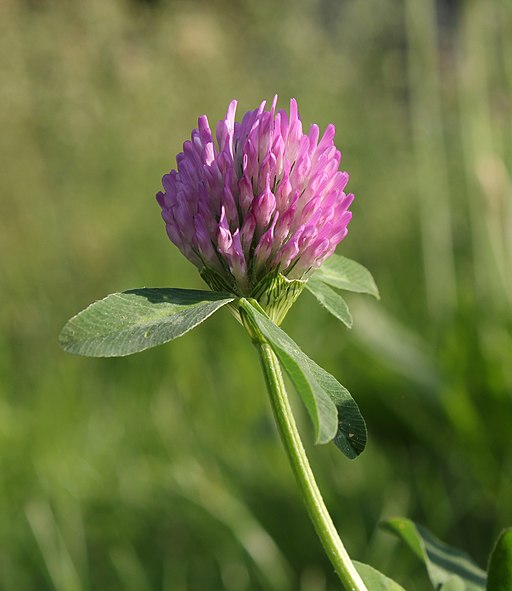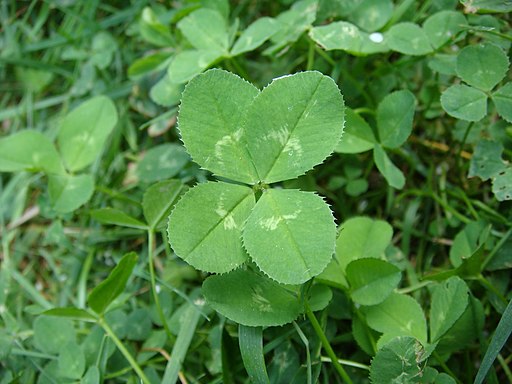Last week we had so much fun learning about dandelions. It is amazing that what many consider a weed can do for your yard as well as food! This week I thought I would look at another wildflower or weed. We will look at clovers! I found many interesting things about clovers. Now many people associate clover with St. Patrick's Day. However for me it is a spring/summer thing because we have so much in our yard and the rabbits come out to eat it.
Fun Facts about Clovers
- There are around 300 species of clover. Clover is also called trefoil. It is in the Trifolium genus in the pea family.
- Clover has the highest diversity in the Northern Hemisphere but also are in South America and Africa. It grows all over the world though.
- Clovers feature alternate compound leaves usually with three toothed leaflets but they can have more. They have nearly spherical heads or spiked flowers that can be white, pink, red, or yellow. They flower in spring and summer.
- Shamrocks are a type of clover. All shamrocks are clover but not all clover are shamrocks.
- The Celts of Wales kept white clover around to ward off evil spirits. Early Christian leaders and/or St. Patrick made the three-leaved plant as a symbol of the Holy Trinity for the Irish people.
- Clover may be included in the bride’s bouquet and the groom’s boutonniere for luck in Irish weddings.
- White clover is a highly invasive plant. However, it does attract bees and rabbits. It is also stays green even in the droughts of summer.
- Clovers take nitrogen from the air and bring it into the plant. Nitrogen is the base of the protein that the clover provides. It helps improve the soil.
- Clover adds protein to small animals such as rabbits and guinea pigs as well as other livestock. It is sometimes used in horse forage cubes and hay.
- Clover is edible. It was eaten by the Irish especially during times of famine. The plant can be chopped up and eaten in a salad and the flowers can be eaten raw or cooked.
- Red clover was brought to America by European settlers for medicinal uses.
- Red clover is known for its ability to loosen phlegm and calm bronchial spasms. It was used to treat Whooping Cough. It is being studied as an alternative to hormone replacement thearapy for menopausal women.
- Red clover is the official state flower of Vermont. It was picked as the state flower in 1894.
- Red clover plants can grow up to 20 inches tall.
- Red clover stems are high in fiber.
- Red clover plants only live for 1 to 3 years.
- The root system of red clover is a well developed tap root which makes it drought resistant.
- Red clover is a rich source of isoflavones.
- Red clover plants parts are said to slow progress of cancerous tumors before ulceration has taken place. The flower is also used in skin problems likes psoriasis and upper respiratory tract problems.
- In Victorian times red clover represented industry.
- In early days clover cordial was a popular drink in San Francisco.
- It was consumed by many Native American people. The Apaches boiled it with grass, dandelions, or pigweed. Ozarks people used red clover tea made with blossoms to cure the whooping, dry or irritable coughs.
- There is a belief that red clover has an ability to treat insect and poisonous snake bites. The plant was boiled in water and the bitten areas were washed with it and crushed leaves were laid on the affected area.
- Red clover is shown to help osteoporosis and cardiovascular health as well as having anti-inflammatory properties. It is said to reduce hypertension, enhance immunity, lowers cholesterol, prevents cancer (breast, endometrial and prostate), and detoxify the body. It is said to help with PMS, eczema, asthma, and speeding up healing a wound. However, consuming excessive amounts are toxic. There are many warnings as well as who should not use it. Look here for more information!

 |
| Red Clover |
 |
| Four-Leaf Clover by Joep01, CC BY-SA 4.0, via Wikimedia Commons |
Four-Leaf (& More) Clover Fun Facts
- Four-leaf clovers were considered lucky in Druid legends. They were considered magical Celtic charms that were said to ward off bad luck. They also used clovers to heal the sick and in religious rituals.
- The four leaves are said to stand for faith, hope, love and luck.
- Four leaf clovers have four leaves but the fourth leave is usually smaller than the others and may be a different shade from the other three. There is 1 four-leaf clover for every 10,000 three-leaf clovers.
- Edward Martin Sr. of Alaska claimed the Guinness World Record for the largest collection of four-leaf clover in 2007. He has more 111,060. He started his collection in 1999.
- In the Middle Ages children believed they would be able to see fairies if they carried a four-leaf clover.
- The first mention of luck from a four-leaf clover in a literary reference in 1620 by Sir John Melton.
- Abraham Lincoln always carried a four-leaf clover. It is reported that he forgot it at home the night he was killed.
- White clover has twice as many chromosomes than humans and many other organisms. Each pair of the white clover’s chromosomes comes from different species. It is believed that the four-leaf clover is a recessive trait but the difficulty in understanding the genetics of the clover makes it hard to really to figure out exactly how they mutate to get the fourth leaf.
- It is said if you give a friend a four-leaf clover your luck will double.
- It is believed that Ireland has the most four-leaf clovers than any other place. This is where the saying “the luck of the Irish” may come.
- There are many four-leafed plants that are mistaken for clovers. Some are pepperwort, water clover, and oxalis. I should note that oxalis or wood sorrel has heart shaped leaves whereas clover has oval leaves. This is a common mistake (as you will see in our craft round-up).
The record for the most leaflets on a clover is 56. This record was set on May 10, 2009. It was bred by a Japanese farmer named Shigeo Obara. He placed decals on leaves when he counted them to make sure his tally was correct.Oxalis (aka. Wood Sorrel) 
Six-Leafed Clover (Dried) by DenisaCZ, CC BY-SA 4.0, via Wikimedia Commons
Sources:
- Brandies. “Red Clover.” http://www.bio.brandeis.edu/fieldbio/Verrill_Wolf/pages/red_clover.html
- Crafty House. “7 Cool Facts About Clovers.” https://crafty.house/cool-facts-about-clovers/
- DiLonardo, Mary Jo. Treehugger. “17 Things You Didn’t Know About Shamrocks.” (08 Feb 2021) https://www.treehugger.com/things-you-didnt-know-about-shamrocks-4863451
- Dotterweich, Lacie. AFIA Feed Bites. “4 Fun Facts on Clover and AG.” (17 Mar 2020) https://www.afia.org/news/afia-blog/4-fun-facts-on-clover-and-ag/
- Garden Weasel. “Fun Facts About Four Leaf Clovers.” (16 Mar 2015) https://www.gardenweasel.com/fun-facts-four-leaf-clovers/
- Grauschopf, Sandra. The Balance Everyday. “11 Juicy Facts About Four-Leaf Clovers.” (15 Feb 2021) https://www.thebalanceeveryday.com/interesting-4-leaf-clover-facts-4117192
- Green Lawn Fertilizing. "How did THAT get in my yard?: Oaxlis."(29 June 2012) https://www.greenlawnfertilizing.com/2012/06/how-did-that-get-into-my-lawn-oxalis/
- Health Benefits Times. “Red Clover-Trifolium pratense.” https://www.healthbenefitstimes.com/red-clover/
- JustFunFacts. “Interesting Facts About Clovers.” http://justfunfacts.com/interesting-facts-about-clovers/
- Kiddle.co. “Clover Facts for Kids.” https://kids.kiddle.co/Clover
- MacPherson, Devon. Frankie Flowers. “10 Fun Facts About Four-Leaf Clovers.” https://www.frankieflowers.com/10-fun-facts-about-four-leaf-clovers
- Pickup Flowers. “Vermont State Flowers.” https://www.pickupflowers.com/flower-guide/vermont-state-flowers
I found a few books featuring clovers. There are not many children's book actually about clover however there are many series with clover in the name. I have not checked out these books so I cannot share much about them.
Now clovers are edible. I didn't have any bloggers volunteer recipes but here are some I found, but I haven't tried any yet (our plants don't have flowers yet and most of the recipes require the flowers):
As for crafts many of them are from St. Patrick's Day. Most people think about clovers around St. Patrick's Day due to shamrocks. Most people also make the mistake of giving clover heart shaped leaves. These are actually wood sorrel. Here are the crafts I found.
2) Beaded Shamrock Craft from Mess for Less
3) 10 Craft Ideas with Free Shamrock and Clover Templates from The Craft at Home Family
4) Shamrock Puppet from Kids Craft Room
5) Shamrock Popsicle Stick Craft from Artsy Craftsy Mom
6) Shamrock Gardens from Mama Smiles
9) Four Leaf Clover Paper Plate Crown by Crafts by Amanda
12) Shamrock Pancakes from The Soccer Mom Blog
You can find more crafts, information and recipes on my Clover Section of my Wildflower Pinterest Board.





